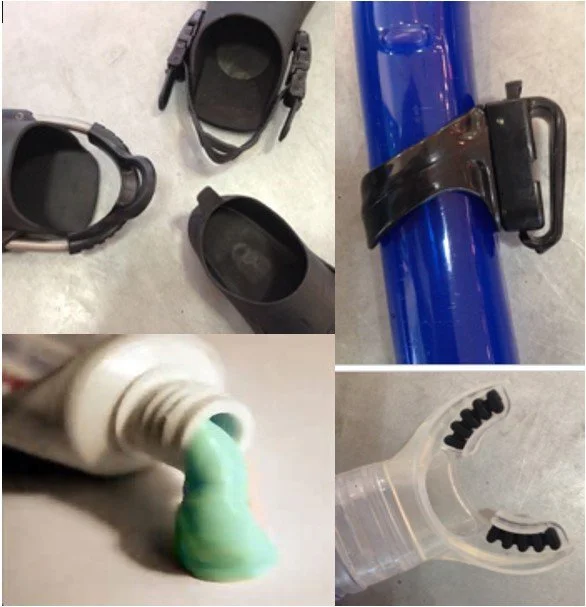
HELPING YOU
EXPLORE OUR WORLD
GEAR SERVICES
THE STUFF YOU CAN DO
Mask - When you get a new mask, it’s important to clean it right away, as oils from the manufacturing process can cause fogging on the lens. Using a mild cleaner or non-gel toothpaste can effectively remove this film. Before each dive, apply a commercial or organic defog solution and keep the mask on your face to prevent the defog from rinsing out or drying up. Remember that a little defog goes a long way, and if you opt for a homemade or organic defog, prioritize eco-friendly options for a cleaner experience. After use, rinse the mask and store it in a cool, dry place away from direct sunlight. Regularly check the strap for signs of wear and tear, and replace it as needed. Use toothpaste as necessary to clean off any chlorine or saltwater buildup.
Snorkel - Attach it securely and start moving! After use, clean it with fresh water and store it in a cool, dry spot away from direct sunlight. Double-check the clip to ensure it remains secure and inspect the mouthpiece to ensure you didn’t accidentally damage it during your last encounter with that really big shark (or another underwater creature)!
Fins - For a proper fit, ensure that your full-fit fins are snug and designed to be worn barefoot. If prolonged use causes discomfort, consider wearing thin neoprene socks for added comfort. Inspect the strap and buckle of adjustable open-heel fins before every dive, and having spare straps on hand can be a game-changer at your go-to dive spot. Additionally, carrying a complete buckle setup is handy for quick replacements. While metal spring straps offer durability, they lack adjustability. Remember to rinse your fins with fresh water and store them in a cool, dry place for optimal maintenance.
Wetsuits - To maintain your wetsuit, including boots, gloves, and hoods, ensure to give them a daily rinse with fresh water during your dive trip and a thorough hot rinse with a mild detergent or wetsuit cleaner like Sink the Stink once you return home. Store your wetsuit in a cool, dry place on a wide hanger or a multi-accessory hanger to keep the in optimal condition.
Drysuits - The maintenance for this suit is similar to a wetsuit. If it leaked or if you were perspiring before or after a dive, clean the inside of the suit accordingly. For suits with latex seals, consider applying a drysuit conditioner. Pay special attention to the zipper by using zipper wax regularly and when storing the suit. Inspect the inflate and deflate valves and seek professional servicing if they are sticking. Check your seals regularly and replace them if they start feeling sticky. Self-changing seals are convenient, but you can also bring your drysuit to us, an authorized dealer, for replacement of wrist, neck, and ankle seals. We can also handle minor repairs for leaking drysuits caused by regular wear and tear. Store the suit in a cool, dry place, either loosely rolled up or on a wide hanger, ideally by the feet.
Accessories - Before diving, inspect your lights, cameras, and other o-ringed items. Clean and lightly lubricate them as necessary, ensuring that any threads are also clean. After use, knives should be rinsed in fresh water and dried outside of their sheath to prevent rusting.
Tanks - Check if the tank is full and has an o-ring. Tanks require minimal maintenance, but it’s crucial to ensure the o-ring is intact and not cracked. Avoid draining the tank completely to prevent water ingress and corrosion. Store tanks with at least 500 psi of air. Have your tank undergo a hydrostatic test and visual inspection at the necessary intervals. A current hydrostatic test date and visual inspection sticker are required by dive centers before a tank can be filled. Rinse the tanks well and store them upright in a secure location where they won’t tip over. Only refill your tank with air from a reputable scuba air station, such as a professional dive center or resort.
WEIGHTS - Regardless of whether you use a weight belt or a weight-integrated BCD, it’s important to verify that the weights are securely fastened and that buckles, clip holders, or Velcro are not worn out. After use, rinse the weights and store them on a flat surface (on the ground).
THE STUFF YOU WANT HELP WITH
Let’s talk about the importance of preventative maintenance. While visual inspections can catch most issues, regulators and BCDs require a different approach. These pieces of equipment have moving parts that are not visible to the naked eye. Manufacturers recommend having them serviced by trained professionals every 1-2 years to ensure they are functioning properly and reduce liability. Just because your gear seems to be working fine, it doesn’t guarantee its safety. While a broken mask or fin strap may not be life-threatening, a malfunctioning regulator or BCD can have serious consequences. That’s why we refer to this equipment as your life support.
BCD - Before you take the plunge, make sure to inflate your BCD. Check for any leaks - if you see or hear one, don’t use it! Remember, even a small leak can be a big problem. Ensure all your clips are still secure and the Velcro is still sticky. The tank strap might stretch when wet, so give it a quick dip before putting your tank on to pre-stretch it. After your dive, give your gear a good rinse with fresh water. Don’t forget to rinse the inside of your BCD too. It’s normal for some water to get inside while adjusting your buoyancy. To clean the bladder, there are aftermarket cleaners available. Store your BCD partially filled with air in a cool, dry place - either hanging up or sitting upright.
During the annual service, we’ll thoroughly check the inflator and possibly replace the o-rings and spring to prevent self-inflation or deflation. We’ll also inspect the deflation valves to ensure they’re not leaking prematurely.
Regulators - Before every dive, make sure to test both your primary and alternate second stages for ease of breathing during your predive check. If you notice that they are difficult to breathe through or have a leak, it’s best not to use them.
After your dive, rinse your regulators in fresh water, making sure to replace the dust cover and avoid pushing on the purge buttons to prevent water from entering the first stage. Hang or place your regulators with the rest of your gear to dry.
It is important to have your regulators examined annually by our technicians. in the first year, a bench test will be performed to check for visible wear on hoses and ensure ease of breathing, making any necessary adjustments.
In the second year, our technician will disassemble your regulator, soaking the plastic pieces and cleaning the metal pieces in an ultrasonic cleaner to remove salt and residue buildup from water. All parts will be inspected, and any components recommended for replacement by manufacturers, such as o-rings, low-pressure and high-pressure seats, and other necessary parts, will be replaced.
The technician will lubricate the regulator, adjust the pressure as needed, and reassemble it to ensure it is ready for your next adventure, whether it be ocean diving or exploring the mountain lakes of Idaho.
For further information or any questions you may have, please feel free to give us a call. Our services typically have a two-week turnaround time for completion.
Once the service on your regulator and BCD are finished, we will provide complimentary pool time for you to test them out. Please make a reservation in advance to ensure availability.





